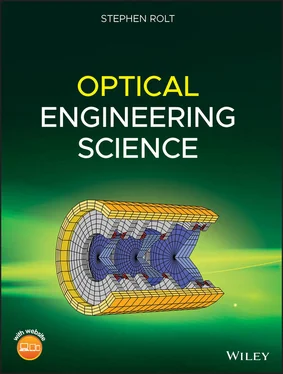The list below sets out the WFE dependence of the five Gauss-Seidel aberrations on pupil function, p, and field angle, θ.
Spherical Aberration: ΦSA ∝ p4
Coma: ΦCO ∝ p3θ
Field Curvature: ΦFC ∝ p2θ2
Astigmatism: ΦAS ∝ p2θ2
Distortion: ΦDI ∝ pθ3
To quantify each aberration, we can define a coefficient, K, which describes the magnitude (in units of length) of the aberration. In addition, as well as normalising the pupil function, we can also normalise the field angle by introducing the quantity, h , which represents the ratio, θ/θ 0, the ratio of the field angle to the maximum field angle.
(3.37) 
(3.38) 
(3.39) 
(3.40) 
(3.41) 
The reader should take particular note of the form of Eq. (3.40). The description of astigmatism here is such that the mean defocus over all orientations of the ray fan is taken to be zero. However, other representations adopt the convention that the defocus is zero for the sagittal ray and the balance of the astigmatism is incorporated into the field curvature. That is to say, in these conventions, the astigmatism is taken to be proportional to cos 2φ, rather than cos2φ, as in Eq. (3.40). Of course, in using cos 2φ, an average defocus of the same form as field curvature is introduced, hence the reason for adopting the convention used here. If the field curvature and astigmatism were redefined according to that convention, then the following revised description would apply:
(3.42) 
(3.43) 
3.6.2 Transverse Aberration Dependence
The ray fan or transverse aberration dependence upon pupil function and field angle is such that the order of the two variables sum to three, as opposed to four for OPD. The dependence of transverse aberration is listed below:
Spherical Aberration: tSA ∝ p3
Coma: tCO ∝ p2θ
Field Curvature: tFC ∝ pθ2
Astigmatism: tAS ∝ pθ2
Distortion: ΦAS ∝ θ3
3.6.3 General Representation of Aberration and Seidel Coefficients
The analysis presented in this chapter has demonstrated the power of using the OPD as a way of describing aberrations. More generally, when expressed as a WFE, it can be used to describe the deviation of a specific wavefront from an ideal wavefront that converges on a specific reference point. As such, this deviation can be used to describe defocus, which shows a quadratic dependence on pupil function and tilt, where the WFE is plane surface that is tilted about the x or y axis (the optical axis being the z axis). The standard representation for describing and quantifying generic WFE and aberration behaviour is shown in Eq. (3.44).
(3.44) 
p is the pupil function and h is the object height (proportional to field angle θ); φ is the ray fan angle .
In the general term, W abc, ‘a’ describes the order of the object height (field angle dependence), ‘b’ describes the order of the pupil function dependence and ‘c’ describes the dependence on the ray fan angle. The defocus and tilt, are of course paraxial terms. Overall, the dependence of each coefficient is given by Eq. (3.45):
(3.45) 
It should be noted that this convention incorporates powers of cosφ, so the astigmatism term contains some average field curvature. Describing each of the aberration coefficients introduced earlier in terms of these coefficients gives the following:
(3.46) 
(3.47) 
(3.48) 
(3.49) 
(3.50) 
Another convention exists of which the reader should be aware. These are the so called Seidel coefficients, named after the nineteenth century mathematician, Phillip Ludwig von Seidel, who first elucidated the five monochromatic aberrations. The coefficients are usually denominated, S I, S II, S III, S IV, and S V, referring to spherical aberration, coma, astigmatism, field curvature, and distortion. They nominally quantify the WFE, as the other coefficients do, but their magnitude is determined by the size of the blur spot that the aberration creates. The correspondence of these terms is as follows:
(3.51) 
(3.52) 
(3.53) 
(3.54) 
(3.55) 
The form of Eq. (3.54)is interesting. When compared to the definition of W 220in Eq. (3.48), an additional amount of astigmatism has been compounded with the field curvature. As such, this new representation of field curvature, S IVrepresents a fundamental and important property of an aberrated optical system and is referred to as the Petzval curvature. Its significance will be discussed more fully in the next chapter.
Читать дальше






























